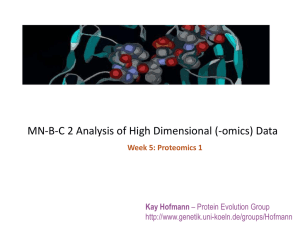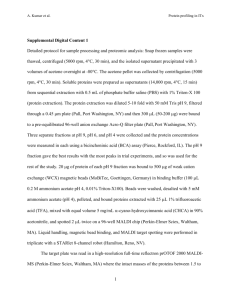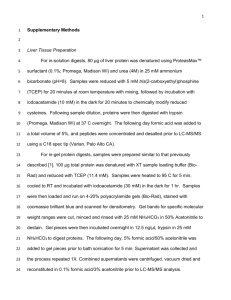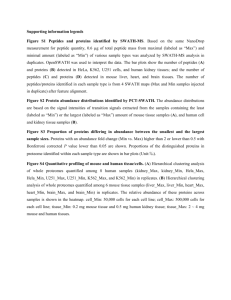pmic7746-sup-0006-figureS1
advertisement
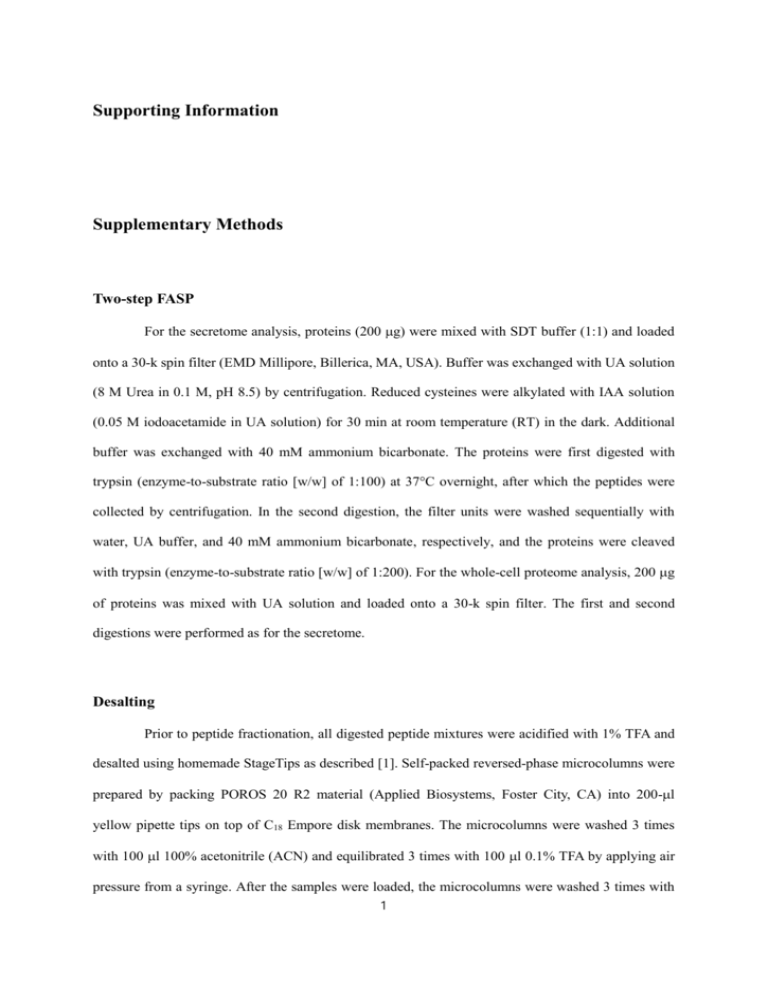
Supporting Information Supplementary Methods Two-step FASP For the secretome analysis, proteins (200 g) were mixed with SDT buffer (1:1) and loaded onto a 30-k spin filter (EMD Millipore, Billerica, MA, USA). Buffer was exchanged with UA solution (8 M Urea in 0.1 M, pH 8.5) by centrifugation. Reduced cysteines were alkylated with IAA solution (0.05 M iodoacetamide in UA solution) for 30 min at room temperature (RT) in the dark. Additional buffer was exchanged with 40 mM ammonium bicarbonate. The proteins were first digested with trypsin (enzyme-to-substrate ratio [w/w] of 1:100) at 37°C overnight, after which the peptides were collected by centrifugation. In the second digestion, the filter units were washed sequentially with water, UA buffer, and 40 mM ammonium bicarbonate, respectively, and the proteins were cleaved with trypsin (enzyme-to-substrate ratio [w/w] of 1:200). For the whole-cell proteome analysis, 200 g of proteins was mixed with UA solution and loaded onto a 30-k spin filter. The first and second digestions were performed as for the secretome. Desalting Prior to peptide fractionation, all digested peptide mixtures were acidified with 1% TFA and desalted using homemade StageTips as described [1]. Self-packed reversed-phase microcolumns were prepared by packing POROS 20 R2 material (Applied Biosystems, Foster City, CA) into 200-l yellow pipette tips on top of C18 Empore disk membranes. The microcolumns were washed 3 times with 100 l 100% acetonitrile (ACN) and equilibrated 3 times with 100 l 0.1% TFA by applying air pressure from a syringe. After the samples were loaded, the microcolumns were washed 3 times with 1 100 l 0.1% TFA, and peptides were eluted with 100 l of a series of elution buffers, containing 0.1% TFA and 40%, 60%, and 80% ACN. All eluates were pooled and dried in a vacuum centrifuge. StageTip-based high-pH fractionation Desalted peptides were resolved in 200 l of loading solution (10 mM ammonium formate solution, pH 10 and 2% acetonitrile) and separated on pipet-based reversed-phase microcolumns, prepared by packing POROS 20 R2 material into a 200-l yellow tip with C18 Empore disk membranes (3M, Bracknell, UK) at the bottom. The microcolumns were washed sequentially with 100 l 100% MeOH and 100% acetonitrile and equilibrated with 100 l of loading solution by applying air pressure from a syringe. Peptides were loaded at pH 10, and 20 fractions were subsequently eluted with buffer solution, pH 10, containing 5%, 10% 15%, 20%, 25%, 30%, 35%, 40%, 60%, and 80% acetonitrile. To improve the orthogonal fractionation of the RP-RP separation, 20 fractions were concatenated into 5 fractions by combining fractions 1, 6, 11, and 16; 2, 7, 12, and 17; 3, 8, 13, and 18; 4, 9, 14, and 19; and 5, 10, 15, and 20 (Fig. 1A). The flowthrough (FT), the elution fraction with 100% acetonitrile, and the peptides that were obtained from the second digestion were pooled into a sixth fraction. The fractionation and pooling took approximately 30 min. Finally, the 6 fractions were dried in a vacuum centrifuge and stored at -80°C until LC-MS/MS analysis. LC-MS/MS analysis The peptide samples were analyzed by LC-MS on an Easy-nLC 1000 (Thermo Fisher Scientific, Odense, Denmark) that was coupled to a nanoelectrospray ion source (Thermo Fisher Scientific, Bremen, Germany) on a Q Exactive mass spectrometer (all from Thermo Fisher Scientific, Bremen, Germany). Peptides were separated on the 2-column setup with a trap column (75 m I.D. x 2 cm, 3 μm, 100 Å) and an analytic column (50 μm ID x 15 cm, 1.9 μm, 100 Å). Solvent A was 0.1% v/v formic acid and 2% acetonitrile, and solvent B was 98% acetonitrile with 0.1% v/v formic acid. 2 In the experiments for our whole-cell proteome and secretome, a 90-min gradient from 2% to 40% acetonitrile was applied to the fractionated peptide samples. All samples were analyzed in technical triplicates. The spray voltage was 1.8 kV in the positive ion mode, and the temperature of the heated capillary was 325℃. Mass spectra were acquired in data-dependent mode using a top 20 method. MS spectra were acquired on an Orbitrap analyzer with a mass range of 300–1800 m/z and 70,000 resolution at m/z 200. HCD scans were acquired at a resolution of 15,000 at m/z 200. HCD peptide fragments were acquired at a normalized collision energy (NCE) of 27. The maximum ion injection time for the survey scan and MS/MS scan was 20 ms and 60 ms, respectively. Data analysis The MS data from the Q Exactive were processed in MaxQuant, version 1.3.0.5 [2] using the Andromeda search engine [3]. Precursor MS signal intensities were determined, and HCD MS/MS spectra were de-isotoped and filtered, such that only the 10 most abundant fragments per 100-m/z range were retained. Protein groups were identified by searching the MS and MS/MS data of peptides against the IPI mouse database (v3.78, 59,534 entries), containing both forward and reverse protein sequences. Data were searched for Trypsin/P specificity. The database search parameters were as follows: the initial precursor and HCD fragment mass tolerances were set to 7 ppm and 20 ppm, respectively; up to 2 missed cleavages were allowed; carbamidomethylation of Cys was set as a fixed modification; oxidation of Met; and acetylation of protein N-term. Minimum peptide length was set to 6 residues. All peptides, modification sites, and protein identifications were filtered at a false discovery rate (FDR) < 1%. To specify the FDR independently for peptides and proteins, peptides that belonged to proteins that did not meet the FDR threshold were removed from the dataset. Peptides were assigned to protein groups, rather than proteins. 3 Bioinformatics analysis The gene ontologies of the whole proteome and secretome were annotated using the DAVID bioinformatics resource (http://www.uniprot.org/). tool (http://david.abcc.ncifcrif.gov/)[4] Pathway analysis was and performed UniprotKB using database the KEGG (http://www.genome.jp/kegg). Secretory protein prediction and functional annotation were performed using SignalP 4.1 (http://www.cbs.dtu.dk/services/SignalP)[5], SecretomeP 2.0 (http://www.cbs.dtu.dk/services/SecretomeP)[6], TargetP (http://www.cbs.dtu.dk/services/TargetP)[7], the Exocarta database (http://www.exocarta.org)[8], (http://www.cbs.dtu.dk/services/TMHMM). 4 and TMHMM, server 2.0 Supplementary Figures Supplementary Figure 1. Detailed flowchart of the proteomic approach and data analysis 5 Supplementary Figure 2. Global feature of astrocyte proteome (A) Sequence coverage of the identified proteins in our astrocyte proteome, including whole-cell lysate (WCL) and conditioned media (CM). (B) Relative proportions for the number of peptides used for identification. (C) Distribution of Andromeda score for the identified peptides. (D) Relative molecular weights of the identified proteins. 6 Supplementary Figure 3. Reproducibility between proteomics analysis Reproducibility between 3 technical and 3 biological replicates is represented by the correlation value, R2. With regard to the abbreviations of the replicates, for example, CM_BR1_tech1 is the technical replicate 1 of biological replicate 1 in conditioned media (CM). Red boxes represents the comparison between technical replicates. 7 Supplementary Figure 4. Precision of proteomic approaches Label-free quantitation intensities of each protein were calculated using Maxquant and transformed into base-2 logarithms. Coefficient of variation (CV) values of the technical replicates from the proteins identified in biological replicate 1 (BR1), biological replicate 2 (BR2), and biological replicate 3 (BR3) of conditioned media (CM) are shown as box plots (A) and histograms (B). CV values of whole-cell lysate (WCL) are also shown as box plots (C) and histograms (D). CVs across biological replicates are described. 8 Supplementary Figure 5. Characterization of C8-D1A proteome Distribution of protein abundance with selected proteins in conditioned media (A) and whole-cell lysate (B). Common astrocyte markers are labeled red. Proteins closely related to astrocyte function are in black. (C) GO term analysis of all identified proteins. GO terms enriched for cellular component, molecular function, and biological process are shown. The number of protein groups according to each GO term is indicated on the right of the bars. 9 Supplementary Figure 6. Label-free quantitation of identified secreted proteins Total proteins identified from conditioned media (CM) were filtered by label-free quantitation (2-fold change), classical secretion, nonclassical secretion, Exocarta, and Gene ontology (GO) analysis. Average number of proteins secreted via the classical secretion pathway (Classical), nonclassical secretion pathway (Non-Classical), and exosomes (Exocarta) and localized to membrane or extracellular space (GO annotation) is displayed as bar graphs. Error bars indicate SD (asterisk, p < 0.05; double asterisk, p < 0.01; compared between 2-fold up and 2-fold down; student’s t-test). 10 Supplementary Figure 7. Comparison between current astrocyte proteome and previous studies (A) Comparison between our mouse astrocyte cell proteome and those of 4 proteomic studies using mouse primary astrocyte cells [9-12]. (B) Comparison between current CM proteome and astrocyte secretome by Skorupa et al. [12]. Accession number for proteins identified in the current study have been changed to gene symbols. 11 Supplementary References [1] Rappsilber, J., Mann, M., Ishihama, Y., Protocol for micro-purification, enrichment, prefractionation and storage of peptides for proteomics using StageTips. Nat Protoc 2007, 2, 1896-1906. [2] Cox, J., Mann, M., MaxQuant enables high peptide identification rates, individualized p.p.b.-range mass accuracies and proteome-wide protein quantification. Nature biotechnology 2008, 26, 13671372. [3] Cox, J., Neuhauser, N., Michalski, A., Scheltema, R. A., et al., Andromeda: a peptide search engine integrated into the MaxQuant environment. Journal of proteome research 2011, 10, 1794-1805. [4] Huang da, W., Sherman, B. T., Lempicki, R. A., Systematic and integrative analysis of large gene lists using DAVID bioinformatics resources. Nature protocols 2009, 4, 44-57. [5] Petersen, T. N., Brunak, S., von Heijne, G., Nielsen, H., SignalP 4.0: discriminating signal peptides from transmembrane regions. Nature methods 2011, 8, 785-786. [6] Bendtsen, J. D., Jensen, L. J., Blom, N., Von Heijne, G., Brunak, S., Feature-based prediction of non-classical and leaderless protein secretion. Protein engineering, design & selection : PEDS 2004, 17, 349-356. [7] Emanuelsson, O., Brunak, S., von Heijne, G., Nielsen, H., Locating proteins in the cell using TargetP, SignalP and related tools. Nature protocols 2007, 2, 953-971. [8] Mathivanan, S., Fahner, C. J., Reid, G. E., Simpson, R. J., ExoCarta 2012: database of exosomal proteins, RNA and lipids. Nucleic acids research 2012, 40, D1241-1244. [9] Dowell, J. A., Johnson, J. A., Li, L., Identification of astrocyte secreted proteins with a combination of shotgun proteomics and bioinformatics. Journal of proteome research 2009, 8, 41354143. [10] Greco, T. M., Seeholzer, S. H., Mak, A., Spruce, L., Ischiropoulos, H., Quantitative mass spectrometry-based proteomics reveals the dynamic range of primary mouse astrocyte protein secretion. Journal of proteome research 2010, 9, 2764-2774. [11] Yang, J. W., Suder, P., Silberring, J., Lubec, G., Proteome analysis of mouse primary astrocytes. Neurochemistry international 2005, 47, 159-172. [12] Skorupa, A., Urbach, S., Vigy, O., King, M. A., et al., Angiogenin induces modifications in the astrocyte secretome: Relevance to amyotrophic lateral sclerosis. Journal of proteomics 2013, 91C, 274-285. 12
